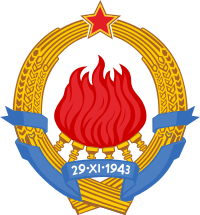Coat of arms of Serbia and Montenegro
| Coat of arms of Serbia and Montenegro | |
|---|---|
 | |
| Versions | |
|
Coat of arms of SFR Yugoslavia, used by Serbia and Montenegro 1992-1993 | |
| Details | |
| Adopted | 1993 |
| Use | As official emblem of the State Union of Serbia and Montenegro, 1993-2006. |
The coat of arms of Serbia and Montenegro was the national symbol of Serbia and Montenegro (Federal Republic of Yugoslavia until 2003).
Official status
The coat of arms was officially adopted by the federal parliament in 1993. It replaced the coat of arms of the Socialist Federal Republic of Yugoslavia which had remained as the Federal Republic's coat of arms from 1992 to 1993. Usage of the arms was discontinued in 2006, after the dissolution of the State Union of Serbia and Montenegro.
Usage as the coat of arms of Serbia and Montenegro
The legal acts which reconstituted the Federal Republic of Yugoslavia into the State Union of Serbia and Montenegro stipulated that a law was to be passed by the end of 2003 specifying the Union's coat of arms and anthem. Such a law was never brought forward, and unlike with the flag and anthem, no notable proposals for a new coat of arms were ever put forward. Thus the State Union continued to use the Yugoslav arms by inertia until its dissolution in June 2006.
Heraldic description
Gules, a Two-headed eagle Argent, en surtout an inescutcheon, quarterly 1 and 4 a lion passant Or (Montenegro) and 2 and 3, a cross between four fire steels Argent. (Serbia)
Origins of coat of arms
The coat of arms was designed after the breakup of the former Socialist Federal Republic of Yugoslavia, to symbolise the new union consisting only of Serbia and Montenegro. Its design thus features the traditional heraldical elements connected historically with both countries.
Throughout history, the arms of both Montenegro and Serbia have featured a double-headed eagle, usually silver, on a shield, usually red, bearing on their chests usually a red shield, which in Montenegro's case contained a golden lion while in Serbia's a cross with four firesteels, usually silver. Thus the arms of FR Yugoslavia were designed by combining these elements: the eagle is the symbol common to both countries, symbolizing their unity, the lions represent Montenegro and crosses with firesteels, Serbia. The red shield in the middle was divided into 4 parts, although the federation consisted of 2 federal units. This was done with the intention to accommodate any possible further expansion of the federation.
The coat of arms was initially proposed by Dr. A. Palavestra in 1992.[1] The final, adopted version followed the same blason as the original proposal but differed in graphical style.
See also
References
- ↑ "Znamenja naseg identiteta", izlozba radova clanova Srpskog heraldickog drustva, Bijeljina, 1994.
External links
| ||||||||||
